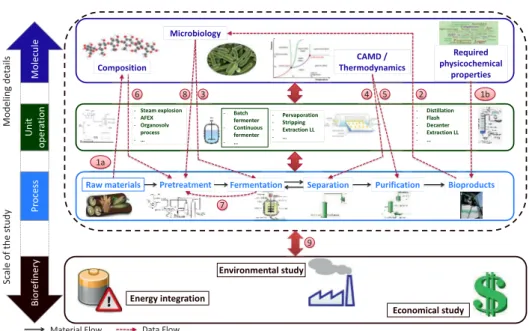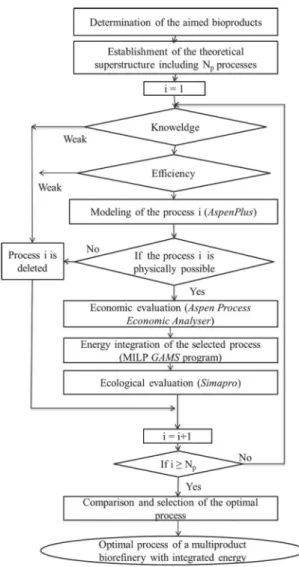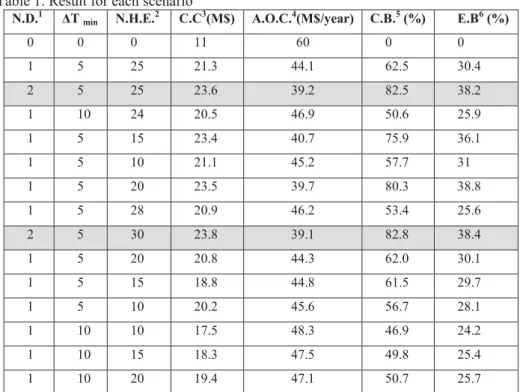To cite this version :
Belletante, Ségolène
and Montastruc, Ludovic
and
Negny, Stéphane
and Thery Hetreux, Raphaële
and Domenech,
Serge
Heat Integration optimization in a Multiproduct Biorefinery. (2017)
Computer Aided Chemical Engineering, 40. 1801-1806. ISSN 1570-7946
O
pen
A
rchive
T
OULOUSE
A
rchive
O
uverte (
OATAO
)
OATAO is an open access repository that collects the work of Toulouse researchers and
makes it freely available over the web where possible.
This is an author-deposited version published in :
http://oatao.univ-toulouse.fr/
Eprints ID : 20392
To link to this article: Doi :
10.1016/B978-0-444-63965-3.50302-0
URL :
http://doi.org/10.1016/B978-0-444-63965-3.50302-0
Any correspondence concerning this service should be sent to the repository
administrator:
staff-oatao@listes-diff.inp-toulouse.fr
Antonio Espuña, Moisès Graells and Luis Puigjaner (Editors), Proceedings of the 27th European Symposium on Computer Aided Process Engineering – ESCAPE 27
October 1st - 5th, 2017, Barcelona, Spain
Heat Integration optimization in a Multiproduct
Biorefinery
Ségolène Belletante
a, Ludovic Montastruc
a, Stéphane Negny
a, Raphaële Théry
Hétreux
a, Serge Domenech
aa
Laboratoire de Génie Chimique, 4 allée Emile Monso, 31432 Toulouse, France ludovic.montastruc@ensiacet.fr
Abstract
The biorefining is a fast-growing topic and laboratory data about biorefineries accumulate sharply, but this type of process is still mainly unknown at the industrial scale. In this context, it is necessary to propose a method that permits to evaluate the industrial interest in order to design and to build the biorefinery. Moreover, the optimization of water and energy consumption represents two of the most important operating costs in a biorefinery. Thus, to limit utilities consumption, energy integration has to be incorporated for all process design alternatives. The proposed MILP program minimizes utilities consumption in coupling cold streams and hot streams through heat exchangers.
Keywords: Heat integration, biorefinery, optimization.
1. Introduction
Nowadays, the main raw material for the chemical industry and energy supply is crude oil. As petroleum resources dwindle permanently, it is necessary to define alternative renewable raw materials and the processes to treat and convert them in order to replace crude oil. The biomass, and especially non-food biomass, is a potential substitute to crude oil for several reasons. Firstly, biomass is a renewable feedstock, thus the environmental impact of chemical industry could be reduced to combat global warming and climate change. Secondly, there are multitude potential conversions pathways for biomass to produce high added value products. Thirdly, the quantity of bio-based wastes increases a lot currently, so their conversion could allow creating a circular economy. Biomass as renewable raw material will definitely be on the rise in deciding countries strategy because it has the potential to contribute to fill chemical and energy needs to ensure countries independence. Currently, to valorize biomass wastes many processes like pyrolysis, gasification, liquefaction and biorefining exist. In this paper, we will focus on the process of biorefining. The biorefining is a fast-growing topic and laboratory data about biorefineries accumulate sharply, but this type of process is still mainly unknown at the industrial scale. Therefore, the economic and ecological viability of the biorefineries in the current level of development is uncertain, especially compared to a perfectly optimized process like the traditional refinery. In this context, it is necessary to propose a method that permits to evaluate the industrial interest in order to design and to build the biorefinery. Moreover, this method should include the design and the optimization of the process in order to make attractive the biorefinery compared to petrochemical process. As a result, the first contribution of this article is to propose a multiscale methodology for the optimal design of multi product biorefinery.
In this methodology, one crucial step concerns heat integration due to large water flowrate and large utilities consumption. Some previous researches focused on the optimization of water and energy consumption, because they represent two of the most important operating costs in a biorefinery. Especially, (Ahmetovic el al. 2010; Grossmann and Martin, 2010; Cucek et al., 2011) worked on the minimization of energy and water consumption in first and second generation biorefinery producing bioethanol. They proposed a two-steps model which minimalized energy consumption by designing the biorefinery from a superstructure with a MINLP program, and then optimized water network to minimize freshwater. They propose a very complete superstructure which encompassed the new technological breakthroughs in the domain. In these previous works it is possible to reduce with some assumptions the number of streams to consider in the heat integration in order to use a classical MINLP program, but in this study no such reduction is stated. Indeed in biorefineries, the heat integration problem contains several cold and hot streams; as a result it is necessary to define a new strategy to solve this problem. In our approach, we propose to use MILP program coupled to scenarii. The program minimizes utilities consumption in coupling cold and hot streams through heat exchangers. The different scenarii vary according the maximal number of heat exchangers allowed for each streams and the approach temperature. A post optimal analysis coupling with a multi criteria decision analysis is used to select the best compromise in term of heat integration.
2. Methodology
2.1. Multiscale modelling
In this section, the methodology is explained in details. The most important point of the proposed model is the multi-scale integration (Belletante et al., 2016): it grows from molecule scale to biorefinery scale, including operating unit and process scales, and each level interacts with others iteratively. The thermodynamic and microbiological data at the molecule scale are used to describe the different unit operations composing the different process phases. Then, during the calculation, we use in turn molecule, unit operation, process and biorefinery scales in function on required data. This integration is depicted in the Figure 1. Moreover, the model can be used in any direction, for instance the starting point of the model can be a desired product or a specific feedstock. We remark that the unit operation scale is very important in the model because it represents the interaction between constrains of the process scale and the experimental data extracted from the molecule scale. Furthermore, the unit operation scale will serve to calculate accurate results based on rigorous equation instead of stating hypothesis. In order to explain the Figure 1, we propose to follow the same way described in the methodology:
1a. Choose the potential feedstock and determine its composition.
1b. Define the required bioproducts and physicochemical properties related on. 2. Take an inventory of any microorganism producing the required bioproducts. 3. Collect data related on the fermentation.
4. Collect thermodynamics data for the separation phase. 5. Collect thermodynamics data for the purification phase.
6. Determine chemical compounds to transform in the pretreatment. 7. Define reactants for the fermentation.
8. Take an inventory of any potential pretreatment transforming the feedstock into the reactants for the fermentation.
Figure 1: Illustration of the multi-scale modeling and optimization of biorefineries
2.2. Resolution organigram
To enable the implementation of this multi-scale methodology, a six steps method was created to obtain the optimal process. The method deals first with the determination of target bioproducts. Then, a superstructure is created, based on the knowledge of the user or expert, and finally it is modeled. Energy integration is then added. Economic and environmental assessments are then carried out in order to compare the different alternatives and select the optimal process. However, this step sequence corresponds to the spine of the method. In reality, iterations and loops are needed. A complete iterative scheme of the methodology is proposed in Figure 2 with four loops. The general loop is used to perform the different previous step for all of the process alternatives, while the three other are used to remove alternatives based on different criteria. First, a process alternative is chosen to enter in the resolution workflow. The alternative then passes the first test for determining if the technology is mature enough to have enough knowledge to be able to consider it. For example, the amount of knowledge must be sufficient to be able to model the process accurately. Using the methodology described in a previous work (Belletante et al., 2016), it is mandatory to simulate the process precisely. For this reason, it is necessary to know the different parameters. If this is not the case, the alternative is removed from the superstructure. This allows you to restrict the superstructure. A second test is then focused on the effectiveness of the alternative according to the literature and calculations information preliminary type 'black box '. Therefore, the alternative is deleted if its effectiveness is low. Finally, the number of alternatives decreased and all alternatives in the superstructure can be modeled and simulated. The last test aims to remove no feasible alternatives after the simulation step, which allows furthering restricting the superstructure. Then, energy integration and assessments are then conducted on these processes to allow their comparison to eventually move towards a unique process.
Data Flow Material Flow Energy integration Environmental study Economical study B io re fi n e ry Separation Pretreatment Bioproducts Microbiology CAMD / Thermodynamics Required physicochemical properties Composition P S B - Distillation - Flash - Decanter - Extraction LL - … - Steam explosion - AFEX - Organosolv process - … S ca le o f th e s tu d y U n it o p e ra ti o n P ro ce ss Pretr P mpos eatm n aration ment rod 1b 2 3 1a 6 8 7
Raw materials eatment FermentationFermen Purification
P ro ce ss M o le cu le M o d e li n g d e ta il s - Pervaporation - Stripping - Extraction LL - … - Batch fermenter - Continuous fermenter - … 4 5 9
Figure 2: Resolution Organigram
2.3. Energy integration
A biorefinery needs a large amount of energy to operate, especially during the pretreatment and purification phase, due to the huge water flowrate in the process. Indeed, in a biorefinery, we estimate that there are 100 to 500 times more (in mass) of water compared to the production of desired bioproduct. Therefore, energy and utilities consumptions are very substantial, and the heat integration is very important in the biorefinery design optimization. .. The synthesis of the Heat Exchanger Network is performed using a MILP program.. The main constraints concern the maximal number of heat exchanges allowed for each stream and the minimum temperature difference between them because they greatly influence the number of heat exchangers in the process on the one hand and the computational time on the other hand. The more the flows are divided, the more the heat exchangers network is complex and better is the minimization of utilities. However, the heat exchangers added for the energy integration increases also the investment of the biorefinery. In the same way, lower is the minimum
temperature difference; lower is the number of heat exchangers. Therefore, we have to impose a limit for the number of heat exchanges and a minimum temperature difference.
3. Case study for heat integration
The case study is the Acetone-Butanol-Ethanol (ABE) production from lignocellulosic feedstock, especially wood. This paper exemplifies the methodology and the multiscale integration from the pretreatment to the purification phase of the process. Biobutanol is promising product as it can replace ethanol in fuels to improve its efficiency. It is a chemical intermediate to create products with higher added value like others chemical products or plastics.
The goal of integration is to reduce consumption in the factory utilities, which allows to improve both the economic and environmental aspects of the biorefinery. Indeed, the reduction of the energy consumption of the process induced some lower operating costs, and the decrease of environmental impact. The problem is classically a MINLP problem similar to the model of (Yee and Grossmann, 1990). However, the resolutions are possible for “small” problems that is, for a number of hot and cold streams less than 5. However, in this study, a biorefinery has potentially several tens of hot and cold streams. For example in our case study, the biorefinery contains 32 hot and 31 cold streams. One possible strategy to reduce this number of streams would be to use the methodology developed by (Rafione et al., 2014). This methodology determined the “main” streams, namely those which have very significant temperature differences and those which have a large enthalpy. The selection is operated using a multi criteria decision aided tool. For the criteria the enthalpy value and the temperature level absolute value are considered. Using Topsis methodology, a ranking is made for the cold and hot streams. In order to use MINLP, a limiting number (5-6) hot and cold are chosen.
However, as the biorefinery contains many identical unit operation characterized by very high enthalpy, it is impossible to implement such a methodology. As a consequence, the proposed strategy is to turn the problem into a MILP formulation, i.e. to no longer calculate the exchange area and the mean logarithmic temperature difference. Thus, different scenarios are described by setting the number of double heat exchangers, the minimum temperature difference and the number of possible divisions by stream. For each scenario, the optimization criterion is the minimization of the sum of hot and cold utilities consumed. Scenarios (ǻTmin, number of division and number maximum interchange of integration) are compared by calculating the Net Present Value and the environmental impact.
For the energy integration, we studied the influence on the profit of the minimum temperature difference (5 and 10°C), of the maximal number of heat exchanges for each stream (one or two) and the number of integration heat exchangers (between 10 and 30). The profit is calculated in using the investment of heat exchanger network and the utilities cost. The energy integration is made on the entire process. According to the table 1, regardless the scenario, the energy integration allows making profit of 20% at least. The scenario with one division and a minimum temperature difference of 10°C is abandoned because it presents the lowest profits while it offers lowest investments. That is the heat exchanger network is less complex than for scenarios with 2 divisions or with a minimum temperature difference smaller; but in turn, the utilities consumption is higher. The scenarios with a minimum temperature difference of 5°C seem more interesting, especially the two scenarios with 25 or 30 integration exchangers (grey in the table 1).
Table 1. Result for each scenario N.D.1 ǻT min N.H.E.
2
C.C3(M$) A.O.C.4(M$/year) C.B.5 (%) E.B6 (%)
0 0 0 11 60 0 0 1 5 25 21.3 44.1 62.5 30.4 2 5 25 23.6 39.2 82.5 38.2 1 10 24 20.5 46.9 50.6 25.9 1 5 15 23.4 40.7 75.9 36.1 1 5 10 21.1 45.2 57.7 31 1 5 20 23.5 39.7 80.3 38.8 1 5 28 20.9 46.2 53.4 25.6 2 5 30 23.8 39.1 82.8 38.4 1 5 20 20.8 44.3 62.0 30.1 1 5 15 18.8 44.8 61.5 29.7 1 5 10 20.2 45.6 56.7 28.1 1 10 10 17.5 48.3 46.9 24.2 1 10 15 18.3 47.5 49.8 25.4 1 10 20 19.4 47.1 50.7 25.7
1 N.D.: Number of divisions, 2 N.H.E.: Number of heat exchanger, 3 C.C.: Capital Cost, 4 A.O.P.: Annual
Operating Costs, 5 C.B.: Cost Benefit, 6 E.B.: Environmental Benefit
4. Conclusion
In support of a framework for biorefinery synthesis design, we have presented a generic methodology to optimize a biorefinery with a rigorous thermodynamics approach. The multiobjective-optimization problem maximizes the profit and minimizes the environmental impact. A biorefinery needs a large amount of energy to operate. Thus, to limit utilities consumption, energy integration has to be incorporated for all alternatives. The energy integration is implemented as a MILP program in order to perform the economic and environmental impact in the same time.
References
Ahmetoviü, E.; Martín, M.; Grossmann, I. E., 2010, Optimization of Energy and Water Consumption in Corn-Based Ethanol Plants. Ind. Eng. Chem. Res. 49 (17), 7972–7982.
Belletante, S; Montastruc, L. Negny, S., Domenech, S., 2016, Optimal design of an efficient, profitable and sustainable biorefinery producing acetone, butanol and ethanol: Influence of the in-situ separation on the purification structure. Biochemical Eng. J., 116, 195-209.
ýuþek, L.; Martín, M.; Grossmann, I. E., Kravanja, Z., 2011, Energy, water and process technologies integration for the simultaneous production of ethanol and food from the entire corn plant. Comput. Chem. Eng. 35 (8), 1547–1557.
Grossmann, I. E.; Martín, M., 2010, Energy and Water Optimization in Biofuel Plants. Chin. J. Chem. Eng. 18 (6), 914–922.
Rafione T., Marinova M.,Montastruc L., Paris J., 2014, The green integrated forest biorefinery: An innovative concept for the pulp and paper mills. Applied Thermal Engineering, 73 (1), 74-81 Yee, T.F., Grossmann, I., 1990, Simultaneous optimization models for heat integration—II. Heat


